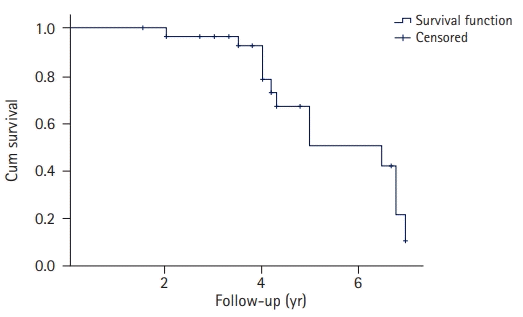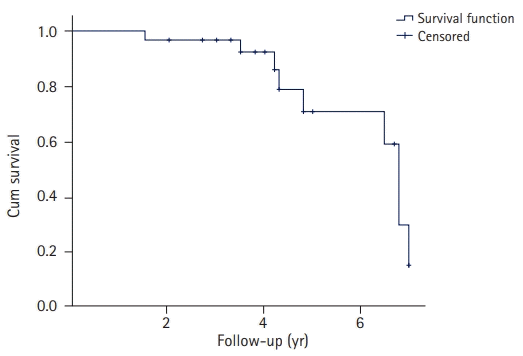1. Pacifico AD. Atrio-ventricular septal defects. In : Stark JF, de Leval MR, Tsang VT, editors. Surgery for congenital heart defects. 3rd ed. Chichester, UK; Hoboken, NJ: John Wiley & Sons;2006.
2. Rastelli G, Kirklin JW, Titus JL. Anatomic observations on complete form of persistent common atrioventricular canal with special reference to atrioventricular valves. Mayo Clin Proc. 1966; 41:296–308.
3. Wilcox BR, Jones DR, Frantz EG, Brink LW, Henry GW, Mill MR, et al. Anatomically sound, simplified approach to repair of "complete" atrioventricular septal defect. Ann Thorac Surg. 1997; 64:487–94.
4. Nicholson IA, Nunn GR, Sholler GF, Hawker RE, Cooper SG, Lau KC, et al. Simplified single patch technique for the repair of atrioventricular septal defect. J Thorac Cardiovasc Surg. 1999; 118:642–6.
5. Reynen S, Hövels-Gürich HH, Vazquez-Jimenez JF, Messmer BJ, Sachweh JS. Long-term outcome up to 40 years after single patch repair of complete atrioventricular septal defect in infancy or childhood. Thorac Cardiovasc Surg. 2021; 69(Suppl 3):e68–75.
6. Stephens EH, Backer CL. Teaching the modified single-patch technique for complete atrioventricular septal defect. World J Pediatr Congenit Heart Surg. 2022; 13:371–5.
7. Cantinotti M, Giordano R, Koestenberger M, Voges I, Santoro G, Franchi E, et al. Echocardiographic examination of mitral valve abnormalities in the paediatric population: current practices. Cardiol Young. 2020; 30:1–11.
8. Geoffrion TR, Singappuli K, Murala JSK. A review of the Nunn modified single patch technique for atrioventricular septal defect repair. Transl Pediatr. 2018; 7:91–103.
9. Azzab S, Samy A, Singab H, Zeinah M, Musollari G, Axiaq A, et al. The effect of surgical technique, age, and trisomy 21 on early outcome of surgical management of complete atrioventricular canal defect. Cardiol Young. 2022; 32:869–73.
10. Ginde S, Lam J, Hill GD, Cohen S, Woods RK, Mitchell ME, et al. Long-term outcomes after surgical repair of complete atrioventricular septal defect. J Thorac Cardiovasc Surg. 2015; 150:369–74.
11. Houck CA, Evertz R, Teuwen CP, Roos-Hesselink JW, Kammeraad JA, Duijnhouwer AL, et al. Dysrhythmias in patients with a complete atrioventricular septal defect: from surgery to early adulthood. Congenit Heart Dis. 2019; 14:280–7.
12. Backer CL, Kaushal S, Mavroudis C. Modified single-patch technique: repairing complete atrioventricular septal defect. Ann Pediatr Cardiol. 2009; 2:51–4.
13. Di Mambro C, Calvieri C, Silvetti MS, Tamburri I, Giannico S, Baban A, et al. Bradyarrhythmias in repaired atrioventricular septal defects: single-center experience based on 34 years of follow-up of 522 patients. Pediatr Cardiol. 2018; 39:1590–7.
14. Backer CL, Eltayeb O, Mongé MC, Wurlitzer KC, Hack MA, Boles LH, et al. Modified single patch: are we still worried about subaortic stenosis? Ann Thorac Surg. 2015; 99:1671–6.




 PDF
PDF Citation
Citation Print
Print





 XML Download
XML Download